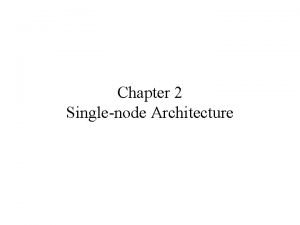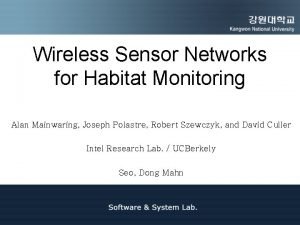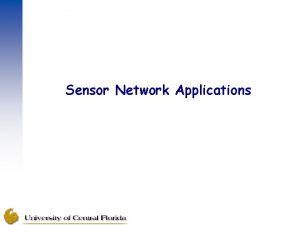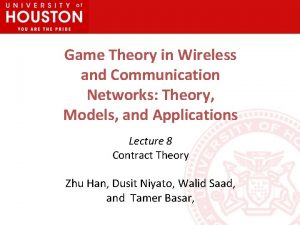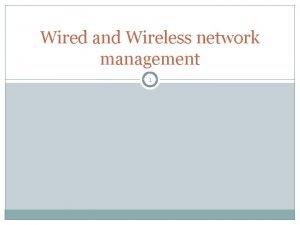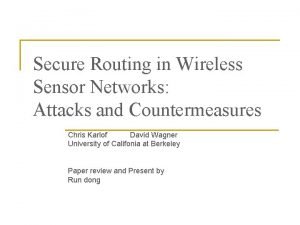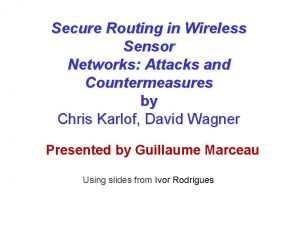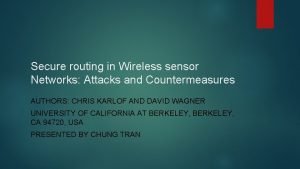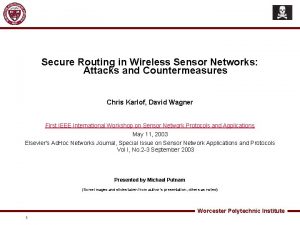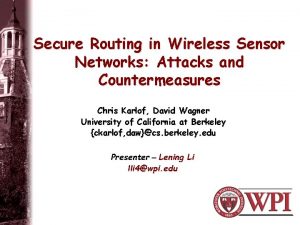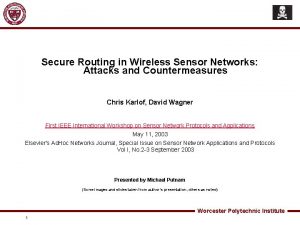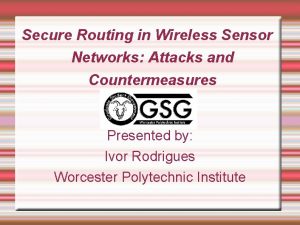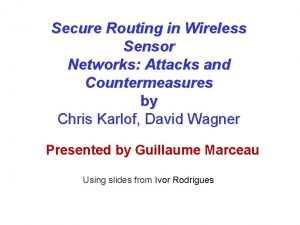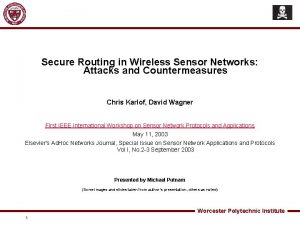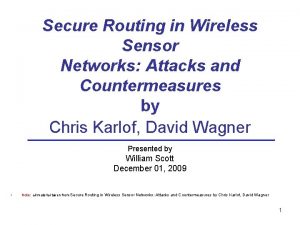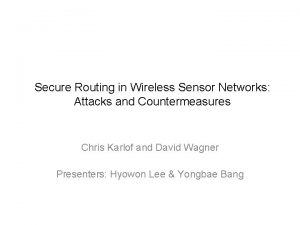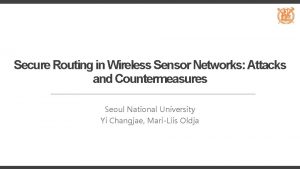Secure Routing in Wireless Sensor Networks Attacks and


















- Slides: 18

Secure Routing in Wireless Sensor Networks: Attacks and Countermeasures Chris Karlof and David Wagner (modified by Sarjana Singh)

Key Contributions n Secure routing issues in WSNs – Show they are different from ad hoc networks – Introduce two new classes of attacks » Sinkhole attack » Hello flood attack n n Analyze security aspects of major routing protocols Discuss countermeasures & design considerations for secure routing in WSNs

WSNs vs. Ad Hoc Networks n n n Multi-hop wireless communications Ad hoc nets: communication between two arbitrary nodes WSNs – Specialized communication patterns » » » Many-to-one One-to-many Local communication – More resource constrained – More trust needed for in-network processing, aggregation, duplicate elimination

Assumptions Insecure radio links n Malicious nodes can collude to attack the WSN n Sensor are not tamper-resistant n Adversary can access all key material, data & code n Base station is trustworthy n Aggregation points may not be trustworthy n

Threat Models n Device capability – Mote class attacker – Laptop class attacker: more energy, more powerful CPU, sensitive antenna, more radio power n Attacker type – Outside attacker: External to the network – Inside attacker: Authorized node in the WSN is compromised or malicious

Security Goals n Secure routing – Support integrity, authenticity, availability of messages in presence of attack – Data confidentiality

Potential Attacks on general WSN routing n Attacks on specific WSN protocols n

Attacks on General WSN Routing Protocols n Spoof, alter, or replay routing info. – Create loops, attack or repel network traffic, partition the network, extend or shorten the source routes and generate false error messages. n Selective forwarding – Malicious node selectively drops incoming packets – Adversary can also modify packets and forward these messages

n Sinkhole attacks – Specific to WSNs – All packets are directed to base station – A malicious node advertises a high quality link to the base station to attract a lot of packets – Enable other attacks, e. g. , selective forwarding or wormhole attack

n Sybil attack – A single node presents multiple ID’s to other nodes – Affect distributed storage, multi-path routing , topology maintenance and geographic routing n Wormhole Attack – Two colluding nodes – A node at one end of the wormhole advertises high quality link to the base station – Another node at the other end receives the attracted packets

n Hello flood attack – Specific to WSNs – In some protocols, nodes have to periodically broadcast “hello” to advertise themselves » Not authenticated! – Laptop-class attacker can convince it’s a neighbor of distant nodes by sending high power hello messages n Acknowledgement spoofing – Adversary spoofs ACKs to convince the sender a weak/dead link supports good link quality

Attacks on Specific Sensor Network Protocols n Tiny. OS beaconing – Construct a BFS Tree rooted at the base station – Beacons are not authenticated! – Adversary can take over the whole WSN by broadcasting beacons

Directed diffusion Base station floods interest for named data and setting up gradients designed to draw events. n – – n Suppression Cloning (Replay interest) Path influence Selective forwarding & data tampering Geographic routing – Adversary false, possibly multiple, location info. – Create routing loop – GEAR considers energy in addition to location

Countermeasures n n n Outsider attacks and link layer security – Prevent outsider attacks, e. g. , Sybil attacks, selective forwarding, ACK spoofing – Cannot handle insider attacks » Wormhole, Hello flood, Tiny. OS beaconing Sybil attack – Every node shares a unique secret key with the base station – Create pairwise shared key for msg authentication – Limit the number of neighbors for a node Hello flood attack – Verify link bidirectionality

n Wormhole, sinkhole attack – Cryptography may not help directly – Good routing protocol design – Geographic routing n Geographic routing – Location verification – Use fixed topology, e. g. , grid structure n Selective forwarding – Multi-path routing – Route messages over disjoint or Braided paths – Dynamically pick next hop from a set of candidates

n Authenticated broadcast and flooding – u. TESLA is a protocol which uses asymmetric key cryptography and minimal packet overhead

Conclusions This paper covers security issues at network layer n WSN security is challenging, new area of research n

Source : http: //www. cs. binghamton. edu/~kang/teachin g/cs 580 s/karlof-wagner. ppt
 Single node architecture in wireless sensor networks
Single node architecture in wireless sensor networks Habitat monitoring sensor
Habitat monitoring sensor Wireless sensor networks for habitat monitoring
Wireless sensor networks for habitat monitoring Difference between reservoir routing and channel routing
Difference between reservoir routing and channel routing Static routing and dynamic routing
Static routing and dynamic routing Continuity equation hydrology
Continuity equation hydrology Clock routing
Clock routing Wired and wireless media
Wired and wireless media Telecommunications, the internet, and wireless technology
Telecommunications, the internet, and wireless technology Wireless sensor network protocols
Wireless sensor network protocols Wireless sensor network ppt
Wireless sensor network ppt Forest geove
Forest geove Sst wireless
Sst wireless Game theory in wireless and communication networks
Game theory in wireless and communication networks Understanding wired and wireless networks
Understanding wired and wireless networks Computer networks routing algorithms
Computer networks routing algorithms Broadcast routing in computer networks
Broadcast routing in computer networks Bluetooth-based smart sensor networks
Bluetooth-based smart sensor networks Bluetooth based smart sensor networks
Bluetooth based smart sensor networks
